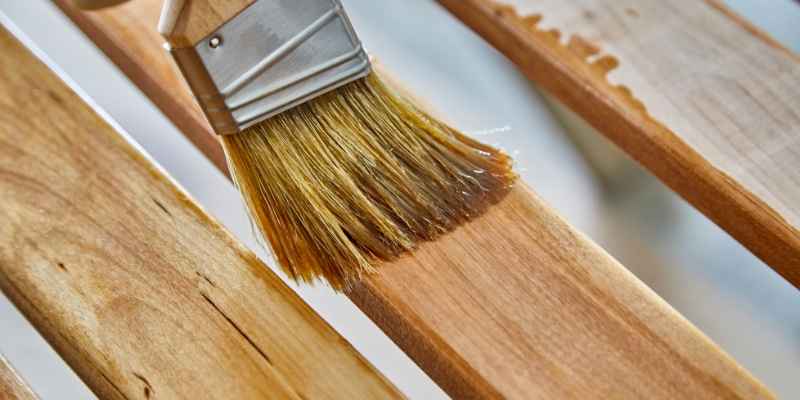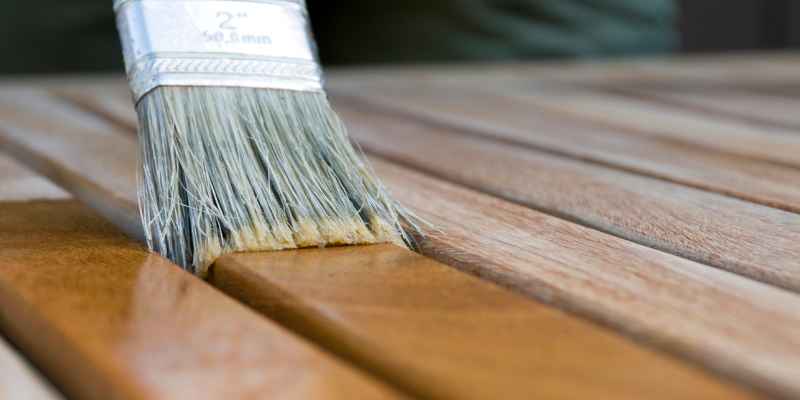To stain pallet wood, first, test the color, then apply the stain evenly and blot any excess dye. Sand pallets for a smooth finish or leave them unsanded for a rustic look before staining.
Prepare the surface, apply stain in even coats, and let dry between applications for best results. Additionally, you can use a DIY aging stain with vinegar and steel wool or weatherproof wooden pallets with varnishes for outdoor use. Following these steps will help you achieve a beautiful, rustic look when staining pallet wood.
Remember to work the stain into cracks and crevices for a deep, penetrating finish, and allow the stain to dry completely before using the pallets.
Preparing Pallet Wood For Staining
When staining pallet wood, proper preparation is key to achieving a beautiful finish. Below are essential steps to follow to ensure your pallet wood is ready for staining.
Sanding The Pallet Wood
Sanding the pallet wood helps to create a smooth surface for the stain to adhere to evenly. Use a medium-grit sandpaper to remove any rough patches or splinters.
Cleaning And Removing Stain
Prior to staining, it is crucial to clean the pallet wood thoroughly to remove any dirt, debris, or previous finishes. This ensures the stain can penetrate the wood effectively for a long-lasting result.
Choosing The Right Stain For Pallet Wood
Staining pallet wood is a crucial step in bringing out its natural beauty. Before choosing a stain, make sure to test different colors to find the perfect match. Applying the stain evenly with a brush or rag and allowing it to dry completely will result in a beautiful, rustic look for your DIY pallet projects.
When it comes to staining pallet wood, choosing the right stain is crucial for achieving the desired look and enhancing the natural beauty of the wood. With a wide range of stains available, it can be overwhelming to decide which one is right for your project. In this section, we will explore different types of stains and even DIY stain formulas that you can try.
Types Of Stains
There are various types of stains available in the market, each with its own unique characteristics and intended use. Here are some common types of stains you can consider for staining pallet wood:
- Liquid Stains: These stains come in liquid form and are easy to apply with a brush or rag. They are available in different sheens, such as matte, satin, and glossy, allowing you to choose the level of shine you prefer.
- Gel Stains: Gel stains have a thicker consistency compared to liquid stains, making them ideal for vertical surfaces like pallet wood. They provide excellent coverage and are less likely to drip or run.
- Oil-based Stains: Oil-based stains penetrate deeply into the wood, enhancing its natural grain and providing long-lasting protection. They are available in a wide range of colors and are suitable for both indoor and outdoor projects.
- Water-based Stains: These stains are environmentally friendly and have low VOC (Volatile Organic Compound) content. They dry quickly and are easy to clean up, making them a convenient choice for your pallet wood projects.
DIY Stain Formulas
If you prefer a more personalized touch, you can also create your own stain formulas using simple ingredients found at home. Here are a few DIY stain formulas that you can try:
| DIY Stain Formula | Ingredients |
|---|---|
| Vinegar and Steel Wool | Plain steel wool pad and vinegar |
| Black Tea and Vinegar | Black tea and vinegar |
To use these DIY stain formulas, simply combine the ingredients as instructed and apply the mixture to your pallet wood using a brush or rag. Experiment with different ratios and application techniques to achieve your desired look.
Remember, before applying any stain, it is important to properly prepare the pallet wood by sanding away rough patches and ensuring a smooth surface for better stain absorption. Additionally, consider the location and purpose of your project when choosing a stain, as some stains provide better protection against weather conditions and UV damage for outdoor use.
With the right stain, you can transform your pallet wood into a beautiful and rustic piece that adds character to any space. Whether you opt for a commercial stain or decide to create your own DIY formula, make sure to test the stain on a small, inconspicuous area of the pallet wood before applying it to the entire project to ensure the desired result.
Now that you have learned about different types of stains and DIY stain formulas, you are ready to choose the right stain for your pallet wood project.
Applying The Stain

After you have prepared your pallet wood, it is time to apply the stain. This step is crucial in achieving the desired color and finish for your pallet wood project. There are a few different methods you can use to apply the stain, depending on your preference and the size of the project.
Using A Brush Or Rag
One common method is to use either a brush or a rag to apply the stain. This allows for greater control and precision, especially when working with smaller pieces of pallet wood or intricate patterns. If you prefer a brush, choose one with bristles that are suitable for applying stain, such as a foam brush or a natural bristle brush.
If you choose to use a rag, make sure it is lint-free to avoid any unwanted fibers getting stuck in the stain. Pour a small amount of stain onto a clean, dry rag and begin applying it to the wood in even strokes, following the grain of the wood. Work in small sections, applying the stain consistently to achieve an even finish.
Ensuring Deep Penetration
In order to achieve a deep and long-lasting color, it is important to ensure that the stain penetrates the wood properly. This can be done by applying a generous amount of stain and allowing it to sit on the wood for the recommended amount of time specified on the product label. The longer the stain sits, the deeper it will penetrate the wood.
After applying the stain, it is crucial to wipe off any excess dye to prevent uneven coloring and blotching. Use a clean, dry cloth or rag to gently blot the wood, removing any excess stain. This will also help to smooth out the finish and ensure an even distribution of color.
Expert Tips For Staining Pallet Wood
Staining pallet wood can add a beautiful rustic touch to your DIY projects. To achieve a professional finish, here are some expert tips to keep in mind:
Use Of Tack Cloth
Before staining, use a tack cloth to thoroughly clean the pallet wood surface and remove any dust or debris. This step ensures a smooth and even application of the stain.
Avoiding Uneven And Blotchy Staining
To prevent uneven and blotchy staining, apply a wood conditioner before staining. This helps the wood absorb the stain uniformly, minimizing any irregularities in the final finish.
If you want a weathered look, you can leave pallets unsanded for a more rustic appearance. For a smoother finish, sand the pallet wood before staining. Remember, the texture of the pallet wood will influence the final result of your stain.
When applying the stain, work in small sections and wipe off any excess dye promptly to avoid buildup and streaks. Let each coat dry completely before applying additional coats for a consistent finish.
Consider experimenting with different staining techniques, such as using vinegar or tea solutions, to achieve unique effects on your pallet wood. And for outdoor projects, make sure to weatherproof the wood with suitable varnishes or finishes to prolong its lifespan.
Enhancing The Aesthetic Appeal
Staining pallet wood not only protects it from the elements but also adds a touch of beauty and charm to any project. By enhancing the natural grain and color of the wood, staining can transform raw pallets into stunning pieces of furniture or decor.
Wood Burning And Staining Techniques
One way to elevate the aesthetic appeal of stained pallet wood is by incorporating wood burning techniques. With a wood burning tool, you can create intricate designs, patterns, or even words on the surface of the wood. This technique adds a unique and personalized touch to your project, making it truly one-of-a-kind.
If you’re new to wood burning, it’s best to practice on the backside of the pallet or on a scrap piece of wood before tackling your main project. This will help you get a feel for the tool and experiment with different techniques and designs.
Aging Stain With Vinegar
Another technique to enhance the aesthetic appeal of stained pallet wood is by creating an aging stain with vinegar. This process involves cutting up a plain steel wool pad and adding it to vinegar, letting it sit for at least a day, and then applying it to the wood. The acidity in the vinegar reacts with the tannins in the wood, giving it a weathered, aged look.
For an extra touch of authenticity, you can also brew up some black tea and brush it on the wood before applying the vinegar solution. This will create a subtle patina and add depth to the final result.
Whether you choose to incorporate wood burning techniques or create an aging stain with vinegar, these methods offer endless possibilities for enhancing the aesthetic appeal of stained pallet wood. With a little creativity and experimentation, you can turn ordinary pallets into extraordinary pieces that will make a statement in any space.
Weatherproofing And Outdoor Use

Treating Pallet Wood For Outdoor Use
Wood pallets may require treatment to withstand outdoor conditions.
- Check for heat treatment to ensure structural integrity.
- Apply varnish or sealant to protect against moisture and UV rays.
- Regular maintenance can extend the lifespan of pallet wood outdoors.
Weatherproofing Techniques
Protecting pallet wood from the elements is crucial for outdoor longevity.
- Sealant application: Coat pallet wood with a weather-resistant sealant.
- Painting: Use outdoor paint to shield against moisture and sun damage.
- Stain with waterproof finishes for added protection and aesthetic appeal.
Best Practices For Beautiful Results
Staining pallet wood can provide a unique and rustic look to your DIY projects. To achieve beautiful results, it’s essential to follow some best practices for staining pallet wood. Whether you are a beginner or want to achieve a specific rustic look, these tips will help you achieve the desired finish.
Tips For Beginners
If you are new to staining pallet wood, start by selecting the right type of stain for your project. Water-based stains are easier to work with and provide a more consistent finish, while oil-based stains offer a deeper color penetration. Additionally, ensure the pallet wood is clean and free from any debris before applying the stain. This will help the stain to adhere evenly and create a professional-looking finish.
Achieving A Rustic Look
To achieve a rustic look, consider leaving the pallets unsanded. This will add character and a weathered appearance to your project. If you prefer a smoother finish, sanding the pallet wood beforehand is recommended. Furthermore, experimenting with different stain finishes, such as vinegar-based or aging stains, can add depth and a weathered effect to the wood, enhancing the rustic look of your project.
Finishes For Pallet Projects
To beautifully stain pallet wood, first sand the surface to ensure a smooth finish. Apply the stain evenly with a brush or rag, working it into the wood for a deep, lasting color. Finally, allow the stain to dry completely before using the pallets for your rustic projects.
Choosing Paints, Waxes, Or Varnishes
When it comes to finishing pallet projects, there are various options to consider. Choosing the right paint, wax, or varnish is crucial to achieving the desired look and protection for your project. Here are some factors to keep in mind when selecting the finish:
- Consider the final finish you want to achieve – whether you prefer a rustic, weathered look or a more polished and sleek appearance.
- Think about the level of protection required for the pallet wood. If your project will be exposed to the elements or dirt, a more durable and weather-resistant finish like varnish might be necessary.
- Evaluate the ease of application and maintenance. Some finishes may require multiple coats or regular touch-ups, while others offer a more straightforward and low-maintenance approach.
Prepping And Finishing Techniques
Before applying any finish to the pallet wood, it’s important to properly prepare the surface for optimal results. Here are some essential prepping and finishing techniques:
- Sanding: If you prefer a smoother and more refined look, sanding the pallet wood is crucial. Use sandpaper to remove any rough patches and create a sleek surface for the finish to adhere to.
- Cleaning: Ensure the pallet wood is clean and free from dust, dirt, and debris before applying the finish. Use a mild cleaner or soap along with a damp cloth to wipe down the surface.
- Staining: When it comes to staining, there are various methods you can use, such as applying the stain with a brush or cloth. Make sure to apply an even coat, working from top to bottom to prevent uneven dripping.
- Drying: Allow the stain to dry completely between coats. Follow the instructions on the label for the recommended drying time. Patience is key to achieving a beautiful and long-lasting finish.
By following these techniques and considering the right finish for your pallet project, you can transform ordinary pallet wood into stunning pieces that add a touch of rustic charm to your home or outdoor space.
Frequently Asked Questions Of How To Stain Pallet Wood
Do You Have To Sand Pallets Before Staining?
You can leave pallets unsanded for a rustic look or sand for a smoother finish. Smooth pallets are easier to paint.
How Do You Paint And Stain Wood Pallets?
To paint and stain wood pallets, follow these steps: 1. Prepare the surface by sanding any rough patches. 2. Mix and apply the stain evenly with a brush, working from top to bottom. 3. Let the stain dry between coats.
4. For an aged look, consider using a vinegar and steel wool solution. 5. To weatherproof for outdoor use, use varnishes or finishes.
How Do You Stain Wooden Pallets With Vinegar?
To stain wooden pallets with vinegar, cut up a plain steel wool pad and add it to vinegar. Let it sit for at least a day and then apply it to the wood. You can also brew and brush on black tea before applying the vinegar solution.
Let it dry before use.
How Do You Treat Pallet Wood For Outdoor Use?
To treat pallet wood for outdoor use, apply a protective varnish or finish to increase longevity. Ensure the wood is heat treated to eliminate bugs.
Conclusion
Achieve a beautiful, rustic look by staining pallet wood with precision and care. Utilize deep, penetrating stains in all the cracks for optimal results. Remember to let the stain dry completely for a professional finish. Enhance your DIY projects by mastering the art of pallet wood staining.


